Physical Address
304 North Cardinal St.
Dorchester Center, MA 02124
Acknowledgment: We wish to thank Dr. Jawa and Dr. Hotchkiss for their excellent chapter in a previous edition of Green’s Operative Hand Surgery and their generosity in permitting much of their text and many of their illustrations to be reused.
The elbow is one of the most constrained and inherently stable joints in the body, owing to numerous bony and soft tissue structures. , Therefore, even simple elbow dislocation, where there is no fracture, indicates substantial soft tissue injury with disruption of the capsule and ligaments. , Due to the joint congruity, it is unusual to observe chronic elbow instability or arthrosis after a stable reduction of a simple dislocation.
In contrast, complex elbow dislocations are defined by capsuloligamentous disruption in association with fracture of one or more of the major bony stabilizers: the radial head, coronoid, or olecranon. , These fractures make the dislocation inherently unstable and almost always necessitate operative intervention to restore alignment and elbow stability. , The risk of recurrent instability and late arthrosis increases with the complexity of the injury and the number of stabilizers that are injured. , , Our understanding of the pathoanatomy of these injuries is advancing rapidly. Although there are still controversies with treatment algorithms, the outcomes of many complex elbow injuries are now predictably good. Successful evaluation and treatment require an understanding of the importance, function, and relationship of each major element of bony and soft tissue anatomy and its contribution to elbow stability.
The primary contributor to elbow stability is the ulnar-humeral joint. It is highly constrained: 180 degrees of the trochlea articulates with the proximal ulna. , , The distal humerus tilts 30 degrees anteriorly, and the semilunar notch tilts posteriorly. , This reciprocal relationship increases the prominence of the coronoid and makes it a key stabilizer of the ulnar-humeral joint. The intact coronoid resists the posteriorly directed moments of the biceps and the triceps ( Fig. 22.1 ). , , The coronoid is also important because the anterior band of the medial collateral ligament (MCL) inserts at its base. The MCL is the primary stabilizer to valgus moments. The anteromedial facet of coronoid in now recognized for resisting varus moments , , , ( Fig. 22.2 ).
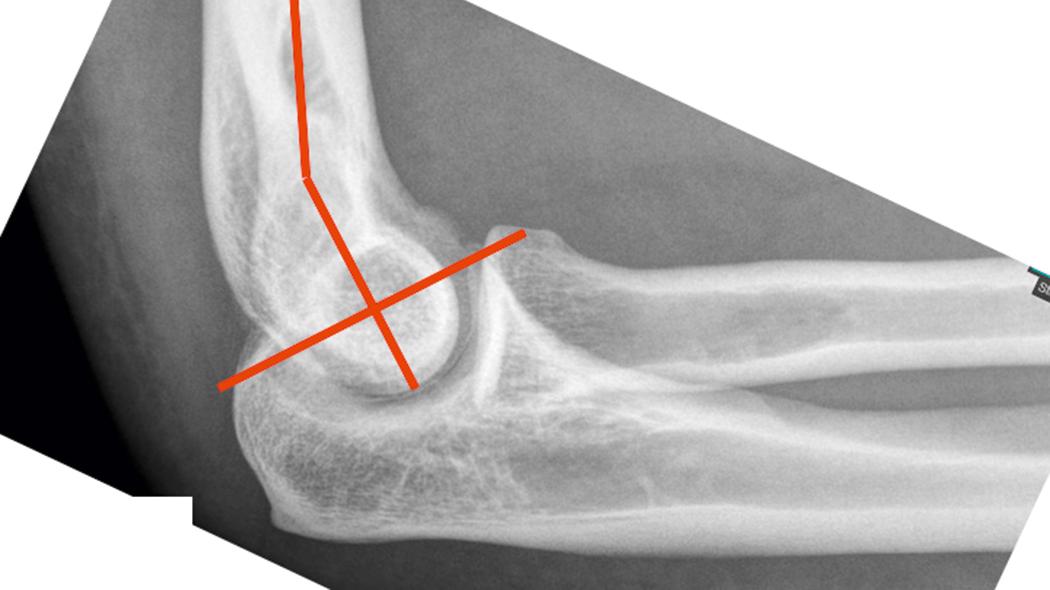
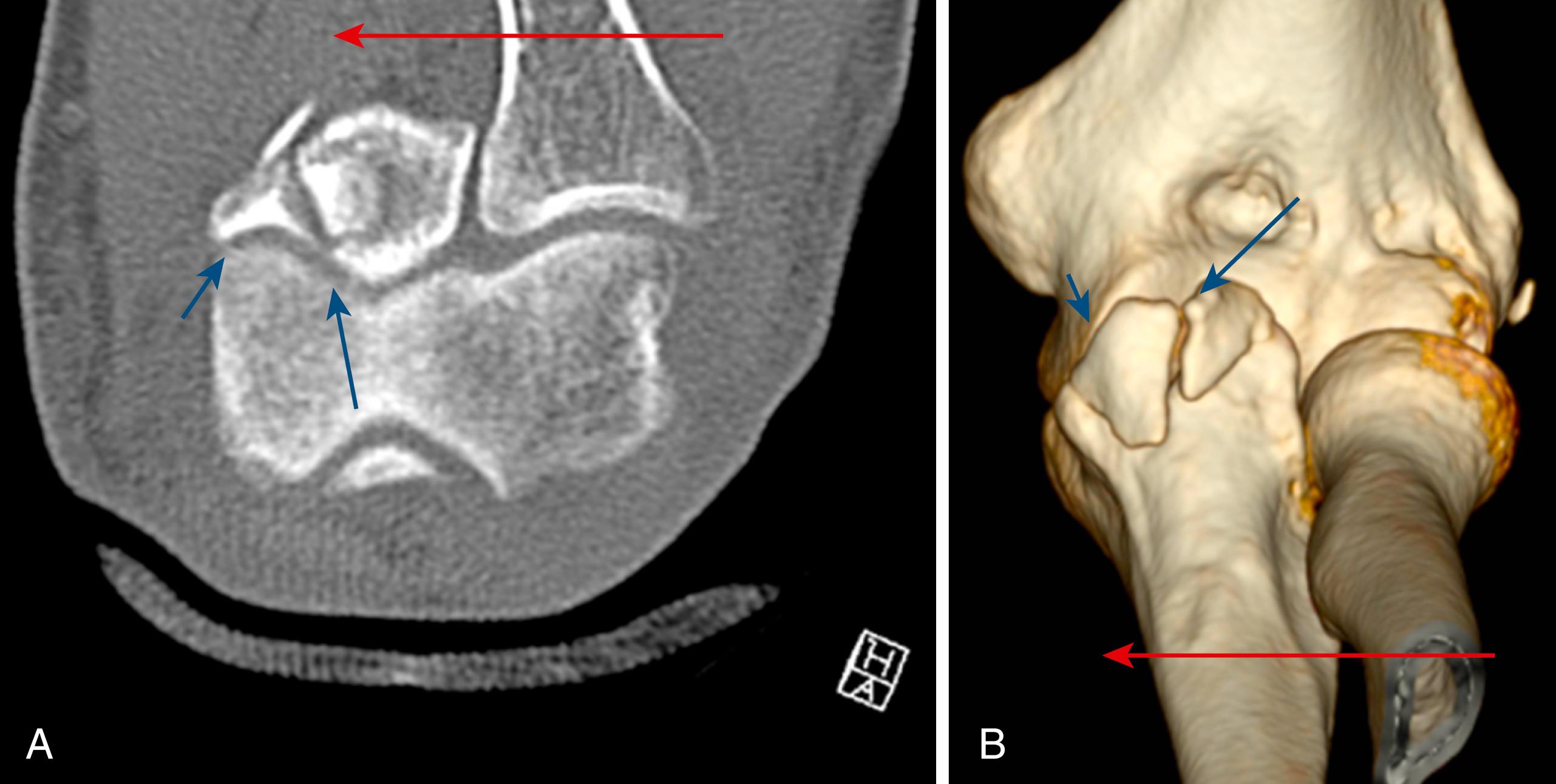
The olecranon process is less important as a bony stabilizer. In cadaveric studies, resistance to posterior translation decreases linearly with olecranon excision, although 50% of the olecranon can be resected without significantly affecting elbow stability. The intact olecranon is important, however, in resistance to valgus moments.
The radial head, along with the coronoid, resists posterior subluxation of the elbow. With other osseous and ligamentous components of the elbow intact, the radiocapitellar articulation contributes minimally to valgus stability. , With MCL or coronoid injury, the radial head becomes the primary stabilizer to valgus stress and prevents subluxation or dislocation of the elbow.
The MCL and the lateral collateral ligament (LCL) are the main capsuloligamentous stabilizers of the elbow. , The MCL is composed of anterior, posterior, and transverse bundles. The posterior and transverse bundles are subtle thickenings of the capsule, whereas the anterior bundle is a robust, identifiable structure that is crucial to resist valgus moments. , , The anterior bundle originates from the medial epicondyle and inserts on the sublime tubercle at the base of the coronoid process. , Medial epicondyle fracture, large coronoid fracture, and MCL tear all are injury variants that can cause valgus elbow instability.
The LCL complex comprises the radial collateral ligament, annular ligament, and posterior band, or lateral ulnar collateral ligament (LUCL). The LUCL originates from the lateral epicondyle and inserts on the supinator crest of the proximal ulna, where it is confluent with the annular ligament. The LUCL is the prime restraint to posterolateral rotatory instability. Additional lateral soft tissues, including the extensor origin and the annular ligament, contribute to resisting posterolateral instability.
The osseous and ligamentous structures all provide static stability for the elbow, whereas the muscles crossing the elbow joint provide dynamic stability. The biceps, brachialis, and triceps muscles help maintain the trochlea in the semilunar notch with posteriorly directed forces. The flexor and extensor masses are secondary stabilizers of the medial and lateral sides. ,
As in all acute fractures, especially high-energy elbow fracture-dislocations, the patient should be evaluated first according to the Advanced Trauma Life Support guidelines. Associated head trauma has an effect on management and outcome of the elbow because of increased incidence of heterotopic bone formation. , Additionally, concomitant fractures, dislocations, and injuries in the ipsilateral upper extremity occur in 10% to 20% of cases. Distal radioulnar joint tenderness may represent an interosseous ligament disruption and should alert the examiner to the possibility of an Essex-Lopresti injury. , ,
Fracture-dislocations are notable for significant swelling, pain, and visible deformity. A thorough neurovascular examination before and after any reduction or manipulation is mandatory because of the high-energy nature of these injuries. Most nerve injuries are secondary to traction. The ulnar nerve is the most vulnerable and commonly injured because of its positioning along the medial ulnohumeral joint line. , Median nerve and radial nerve injuries are rare but have been reported, including entrapment of both nerves in the joint. , Stretching and tearing of other anterior structures, including the brachial artery, have been reported and rarely can lead to ischemia and compartment syndrome. These injuries are seen more often in pediatric patients.
Monitoring of the soft tissue swelling is essential because forearm compartment syndrome must always be considered in high-energy injuries. A “floating forearm” injury, where a more distal radius fracture occurs together with an elbow fracture, is particularly associated with forearm compartment syndrome.
For patients who present for delayed treatment or who may have had previous surgery, a careful assessment of their range of motion, pain, and nerve function should be recorded. Ulnar nerve function may be already diminished without the patient being aware, overshadowed by the pain and overall impact of the elbow injury. Elbow flexion and extension and forearm rotation should be measured.
Anteroposterior and lateral radiographs of the elbow are necessary; however, it is often difficult to evaluate these complex injuries fully with the initial radiographs. Trauma films may be inadequate because of patient positioning, pain, deformity, bandages, and splinting material. Radiographs of the shoulder, wrist, and hand should also be included to rule out ipsilateral injuries. Two-dimensional and three-dimensional reformatted computed tomography (CT) scans of the elbow after closed reduction are extremely helpful for understanding the injury pattern and for preoperative planning. CT scans identify and help quantify injuries of the coronoid, radial head, or olecranon that may have been missed on plain radiographs. Lastly, fluoroscopic examination under anesthesia is useful while making operative decisions for treatment.
In cases in which the patient has undergone previous treatment but has an elbow that remains either dislocated or unstable, imaging must be tailored to the individual circumstances. Plain radiographs are mandatory, but because the joint is often stiff and the patient is unable to change its position, this situation requires some creativity and collaboration with the radiology staff for nonstandard views. The goal of plain radiographs is to document the integrity and alignment of the articulating surfaces of the distal humerus, radial head, and proximal ulna. Displaced articular fragments may be difficult to see. Internal fixation and radial head implants can obscure the joint surfaces and alignment. In these cases, both CT scans and occasionally magnetic resonance imaging (MRI) can be helpful.
Most complex dislocations occur from a high-energy injury, such as a fall on an outstretched hand or motor vehicle accident. In 90% of dislocations, the injury is a combination of valgus, supination, and axial directed moments that combine to cause a posterior or posterolateral displacement of the proximal ulna from the trochlea. , , , Sequential and predictable disruption starts from the lateral side and moves anteriorly and posteriorly to the medial side. This pattern of injury is commonly referred to as the Horii circle. , The LCL complex is one of the first injured structures and is usually avulsed from the lateral epicondyle. The anterior band of the MCL is the last structure injured, and experimentally the elbow may dislocate with it intact. This sequence, predicted by biomechanical testing models, seems to be true based on imaging review of actual injury. The flexor and extensor origins have a variable degree of injury. , Depending on how the energy is dissipated, the trauma may result in pure capsuloligamentous disruption and a simple elbow dislocation or a complex dislocation with fractures of the radial head or coronoid or both. , ,
Ulnar-humeral dislocation is seen in less than 10% of radial head fractures ( Fig. 22.3 ). These are higher-energy injuries than simple dislocations and involve greater instability and a higher risk of arthrosis. Hotchkiss’s modification of the Mason classification (see Chapter 19 ) provides a useful scheme for evaluation. In the context of a fracture-dislocation, type I fractures do not require operative intervention, type II fractures require fixation, and type III fractures require replacement arthroplasty. The LCL is typically avulsed from its origin at the lateral epicondyle and must be addressed surgically. Disruption of the MCL is less common and may be better tolerated, although the importance of medial ligamentous injury is becoming better understood.
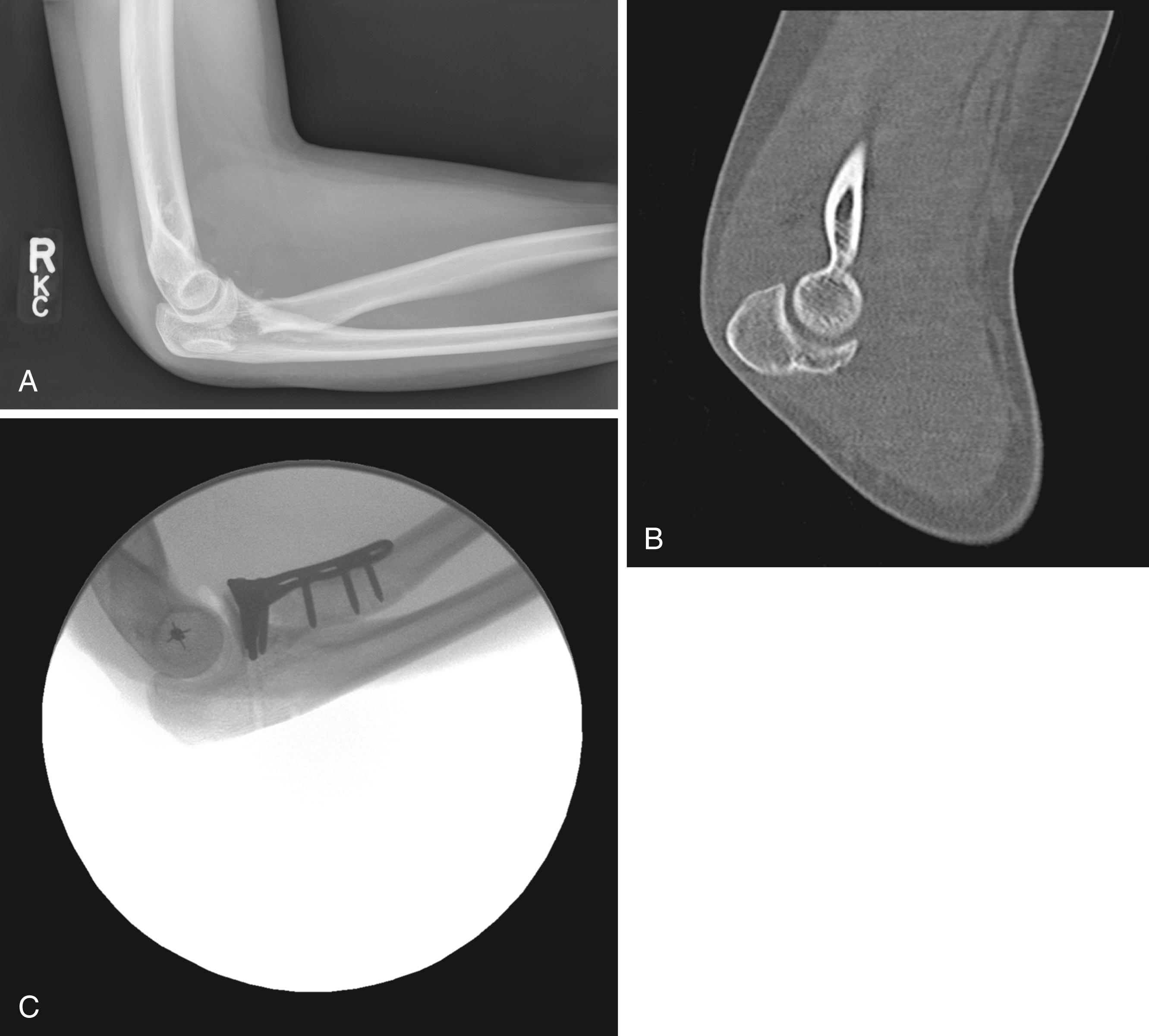
These injuries have an increasing threat of persistent instability and posttraumatic arthrosis , , ( Fig. 22.4 ). Coronoid fractures may be classified by their location and size into tip fractures, anteromedial fractures, and basal fractures ( Fig. 22.5 ). Subtype I tip fractures are 2 mm or smaller in size. Subtype II fractures are greater than 2 mm in size but do not extend into the sublime tubercle. , The distinction between the two subtypes is arbitrary; however, this does not seem to affect treatment. The anterior capsule is usually still attached to the coronoid piece and must be considered (but not necessarily addressed) when treating this fracture. Anteromedial and basal fractures are typically seen with varus posteromedial rotational injuries and olecranon fracture-dislocations and are discussed in the next sections. The LCL and MCL are disrupted, although sometimes the anterior bundle of the MCL may remain intact. Ultimately, elbow stability is proportional to the size and location of the coronoid fracture, the extent of radial head comminution, and the severity of ligamentous disruption. ,
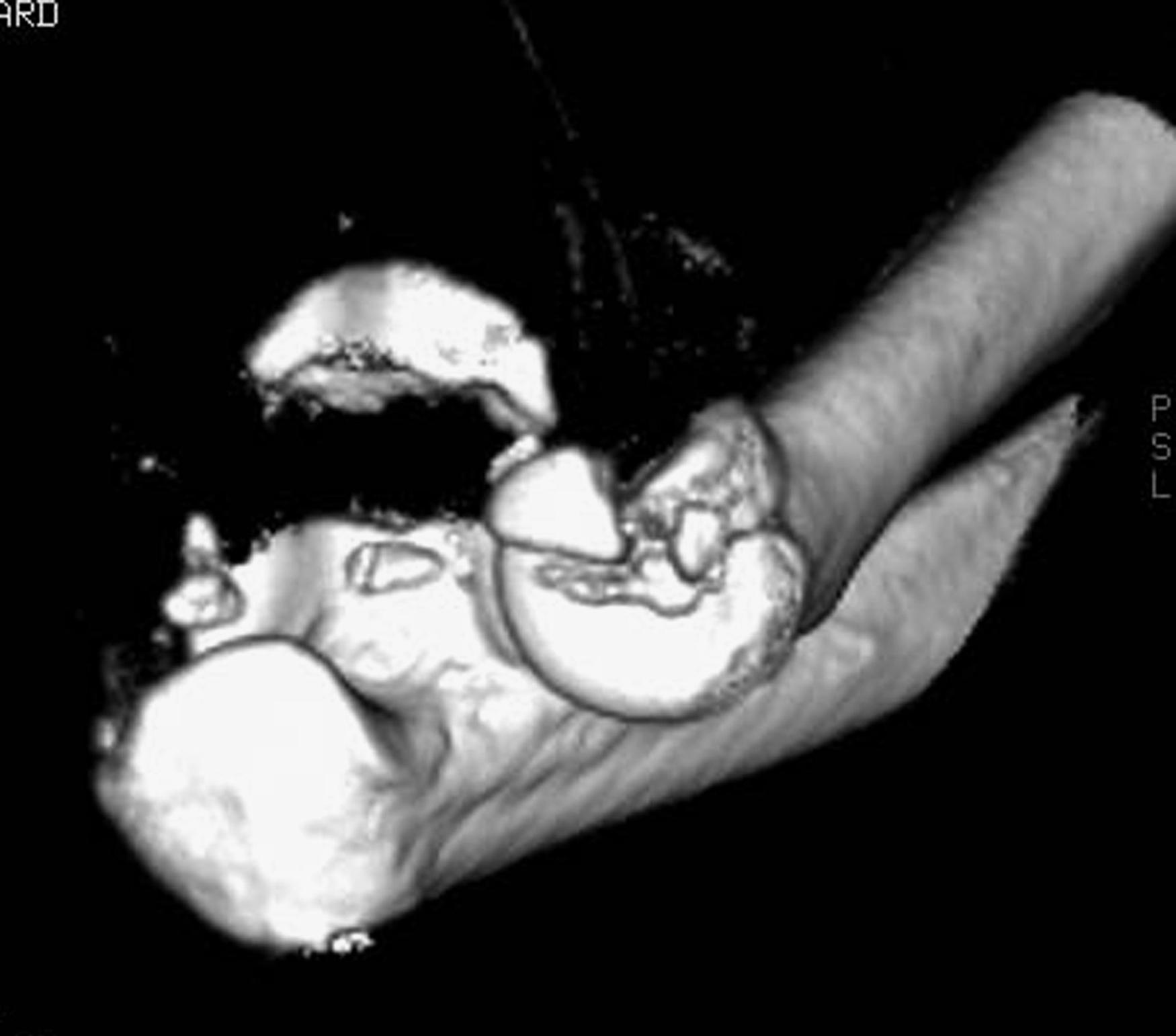
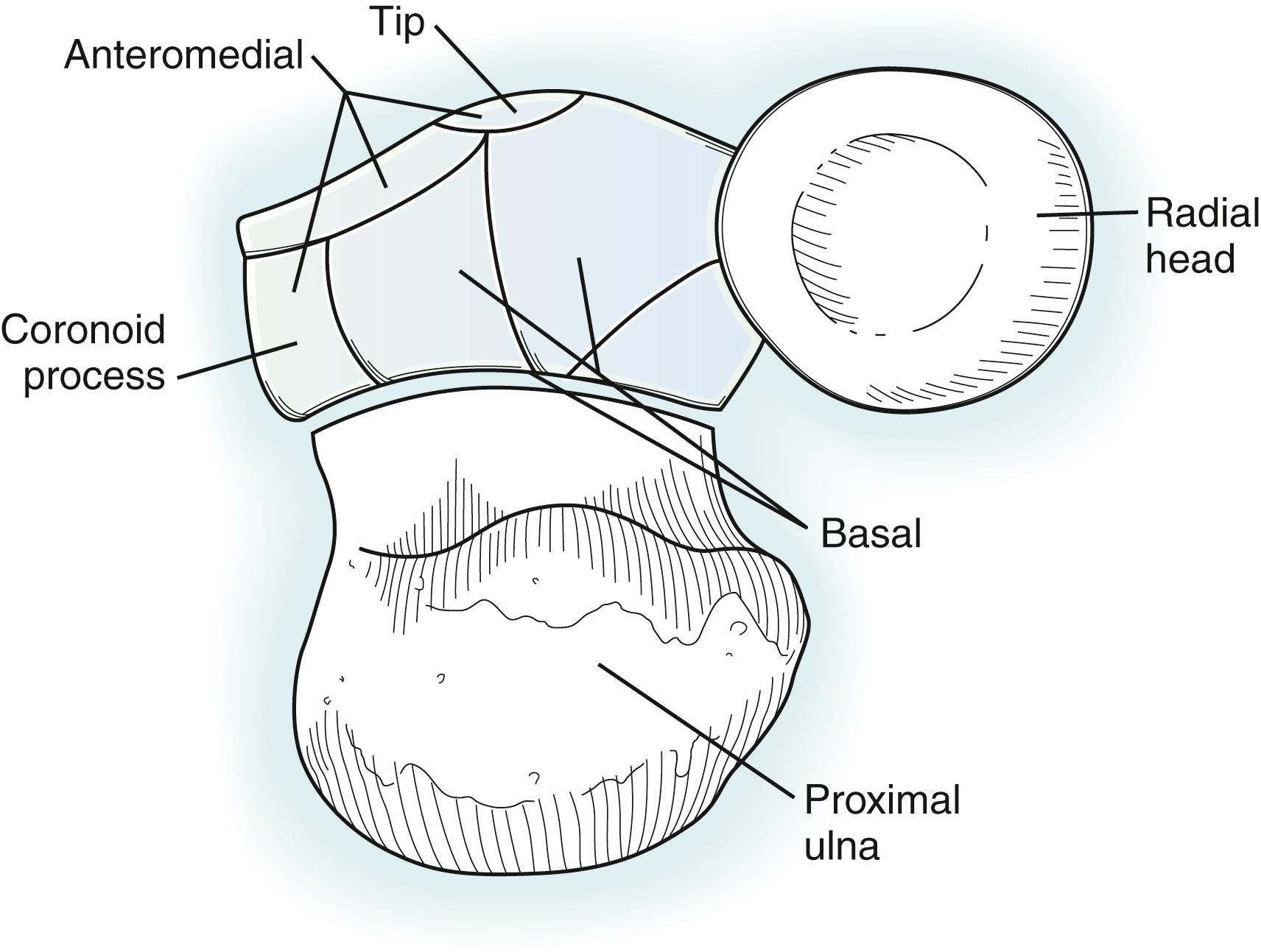
Olecranon fracture-dislocations typically represent the next stage in the continuum of instability and complexity and include disruption of the semilunar notch, dislocation or fracture or both of the radial head, and fracture of the coronoid process. , There may be complete disruption of all osseous stabilizers of the elbow. These injuries may not be true dislocations, however, because the apposition of the articular surfaces may be maintained. The coronoid fractures are typically one large piece (>50% height) but may also be comminuted; the basal subtype II fractures are most commonly associated with olecranon fractures , (see Fig. 22.5 ). These fracture-dislocations can be divided into anterior and posterior injuries, which have different mechanisms and injury patterns.
Transolecranon fracture-dislocations are less common and are caused by a high-energy direct blow to the forearm. Depending on the mechanism and direction of the blow, the forearm may be dislocated either anteriorly or posteriorly, but the injury is defined by a complex olecranon or proximal ulna fracture, dislocation of the forearm, and maintenance of the proximal radioulnar relationship , , ( Fig. 22.6 ). This injury pattern was first described and named “trans-olecranal fracture dislocation” in 1974 by Biga and Thomine. This and subsequent studies emphasized the distinction from Monteggia fractures, in which the radioulnar relationship is dissociated. , When the capsuloligamentous structures are maintained, the elbow is typically rendered stable once the proximal ulna anatomy is reduced and fixed. Even when ligamentous repair is required, outcomes are often favorable. This is because the forearm is not disrupted, so good recovery of forearm rotation can be expected.
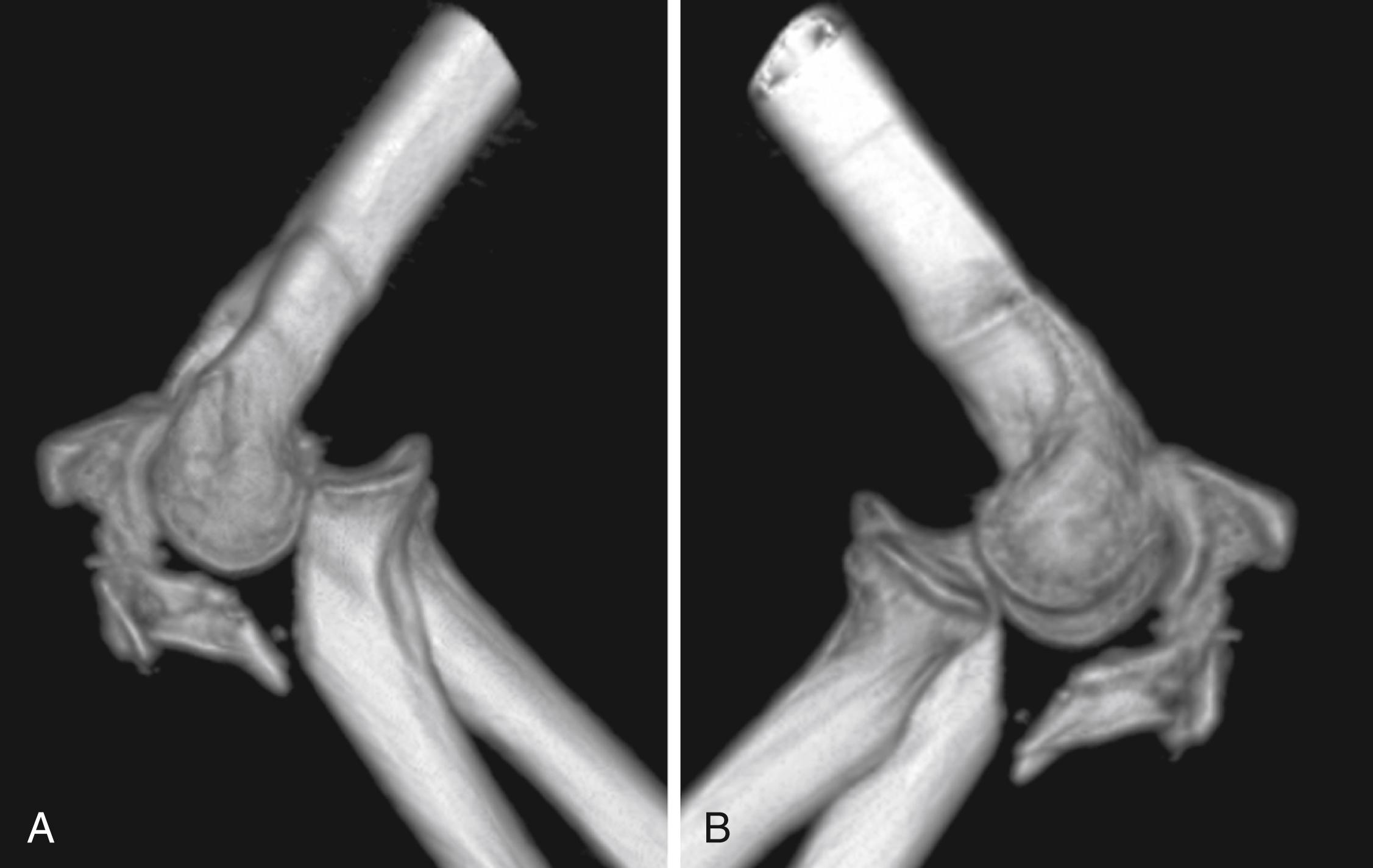
Chapter 20 explores the Monteggia lesion in detail. In brief, Penrose proposed that the posterior Monteggia lesion is a type of fracture-dislocation of the elbow , , , ( Fig. 22.7 ). The injury is usually seen in older, osteopenic women after a low-energy fall onto the elbow. The injury is characterized by a posterior radial head dislocation, a proximal ulnar fracture, a coronoid fracture (basal subtype II), and ulnar-humeral instability. , , The coronoid fracture is more variable than with anterior injuries, may involve the tip or the anteromedial facet, and may be comminuted. The radial head is fractured in two-thirds of injuries. The LCL may be injured, but the MCL is typically spared. In contrast to anterior olecranon fracture-dislocations, instability may persist after restoration of the bony stabilizers. Posterior Monteggia injuries can be classified as follows , :
Type A: Fractures including the coronoid process
Type B: Fractures of the ulnar metaphysis
Type C: Fractures of the ulnar diaphysis
Type D: Complex, comminuted fractures of the entire proximal ulna
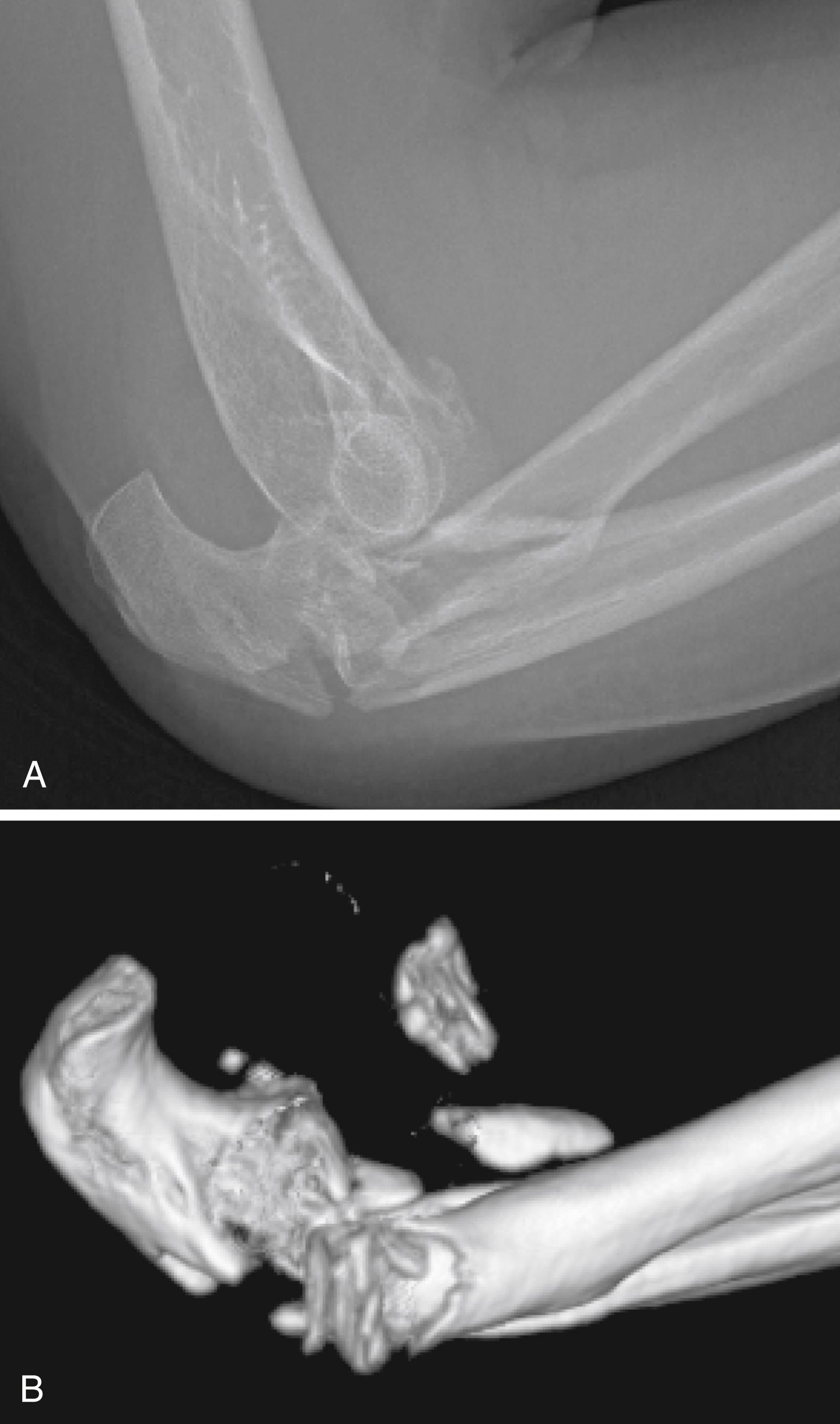
Varus posteromedial rotational injury is a less common variant. , Similar to olecranon fracture-dislocations, these injuries may not be true dislocations as the relationship of the articular surfaces is maintained ( Fig. 22.8 ). In these injuries, a fall on an outstretched arm with the shoulder in flexion and abduction creates a varus, posteromedial rotational force on the forearm. This force causes the LCL complex to tear from the lateral epicondyle in tension. Simultaneously, the medial coronoid process is forced against the medial trochlea and sometimes results in an anteromedial facet fracture of the coronoid. The coronoid fracture can just involve the anteromedial rim (subtype I), extend to involve the tip with comminution (subtype II), or involve the sublime tubercle and the attachment of the anterior band of the MCL (subtype III) (see Fig. 22.5 ). Anteromedial facet fractures are seen in combination with elbow dislocation, sometimes with an olecranon fracture, but rarely with an associated radial head fracture. This fracture pattern of instability may show only subtle joint incongruity and may be missed, leading to rapid development of arthrosis. , , ,
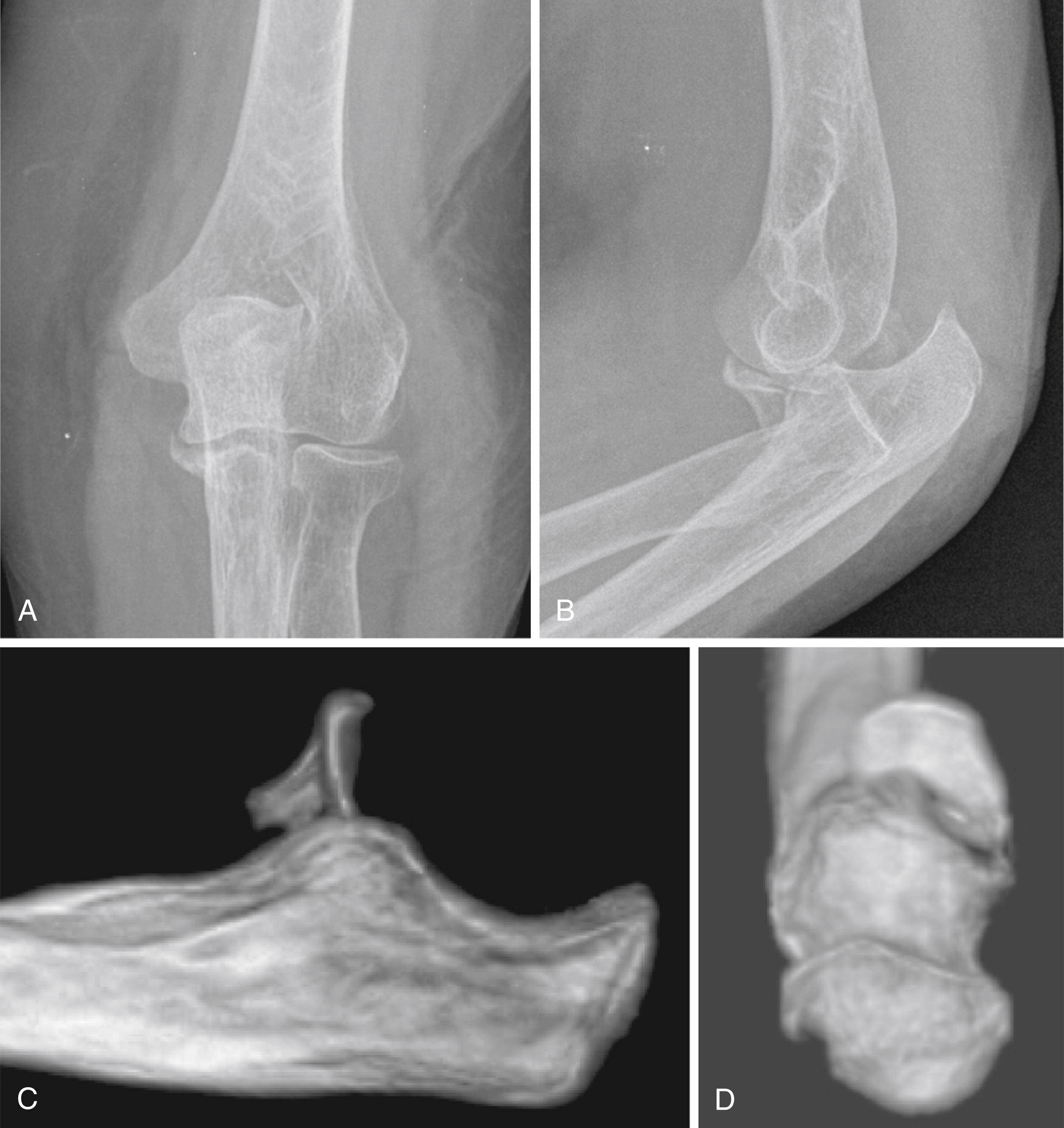
In 1927, McWhorter reported on his indications and techniques for treatment of olecranon and coronoid fractures. His technique of exposure of the coronoid and proposed fixation with suture or a screw is very similar to what we do today. He recognized almost 90 years ago that coronoid fractures associated with dislocations and radial head fractures had poor outcomes. He encouraged operative fixation of displaced fractures and early motion—concepts that we are currently rediscovering.
After McWhorter’s work, the diagnosis and treatment of elbow fracture-dislocations progressed slowly for several decades. Poor outcomes were acknowledged, but the critical components of elbow instability were not recognized. It was not until the 1980s that Josefsson and colleagues , made the clear distinction between the excellent long-term outcomes of simple elbow dislocations and the poor outcomes of fracture-dislocations.
Subsequently, understanding of the patterns of injury and treatment of complex elbow dislocations continued to expand rapidly. Regan and Morrey , classified and recognized the importance of the coronoid fracture to stability, whereas Hotchkiss formally recognized the terrible triad injury pattern, which McWhorter described 80 years earlier.
Since 2000 there has been steady improvement in our understanding of the pathoanatomy of elbow fracture-dislocations and the development of standard ways of approaching them surgically. O’Driscoll, Morrey, and others have better defined the mechanism of dislocation and the fracture-related anatomy of the MCL. , Schneeberger and others elucidated the relationship between the bone and ligament stabilizers and the mechanisms of dislocation. , Using detailed analysis of imaging, Ring, Jupiter, and Doornberg have improved our understanding of the osseous anatomy of the coronoid and called particular attention to its anteromedial facet. , , McKee and colleagues published what they called a “standard protocol” for addressing the terrible triad injury, with systematic management of coronoid and anterior capsule injury, radial head fracture, and LCL injury, in that order. These advances have led to substantially better outcomes for patients with these injuries. Yet problems remain including stiffness, associated nerve injury, , and heterotopic ossification.
Treatment of acute injuries is done with the intention of establishing sufficient stability to allow for early active motion. The first step is to restore osseous stability by anatomically aligning and stabilizing the articular surface of the semilunar notch. Next, the radial head and the radiocapitellar contact need to be restored. Finally, the ligaments need to be repaired. The LCL complex is more important to stability in the setting of complex traumatic dislocations than the MCL. Typically, the MCL does not need to be repaired and heals with the restoration of bony anatomy and with active motion. Rarely, one can see residual medial instability, which can lead to arthosis.
Simple dislocations should be managed by immediate closed reduction. Reduction requires adequate relaxation and analgesia but can be readily performed in the emergency department with conscious sedation and intravenous medication. The reduction maneuver requires translation of the forearm to the trochlea in the coronal plane, followed by firm pressure on the olecranon tip to push the ulna distally. This allows the trochlea to fall into the semilunar notch. Successful reduction is accompanied by a clunking sensation. The elbow should be tested for stability at this point by taking it through a range of motion. Most elbows are stable after reduction but may have a tendency for redislocation in extension or with valgus stress. Radiographs should confirm a concentric reduction, and the elbow should be splinted in approximately 90 degrees of flexion for 1 week, at which time repeat radiographs should confirm reduction.
Splinting can help reduce swelling and pain but should not be prolonged. Motion should be started after the first week, although splinting for 2 weeks does not seem to affect long-term outcomes. Splinting beyond 3 weeks increases the risk of persistent flexion contracture and pain and may predispose to heterotopic ossification. ,
Sometimes, slight postreduction subluxation of the elbow is identified on postinjury radiographs and is known as the “drop sign.” This is analogous to pseudosubluxation of the shoulder after closed reduction and can be treated with exercises and avoidance of varus stress. Exercising supine with the elbow overhead uses gravity to maintain reduction and improves the patient’s self-confidence. Infrequently, simple elbow dislocations are unstable after reduction and require operative intervention with ligamentous repairs or skeletal fixation.
Closed reduction of the elbow dislocation is performed, as described earlier. Fracture of the radial head with an associated ulnar-humeral dislocation creates an additional potential cause of elbow instability. CT scans are useful to rule out subtle, but important, coronoid fractures that may necessitate operative intervention. The radial head generally should not be resected (without replacement) in the setting of dislocation because the injured ligaments must heal at the correct length and tension. Maintenance of radiocapitellar contact is important in the early postinjury period.
Become a Clinical Tree membership for Full access and enjoy Unlimited articles
If you are a member. Log in here